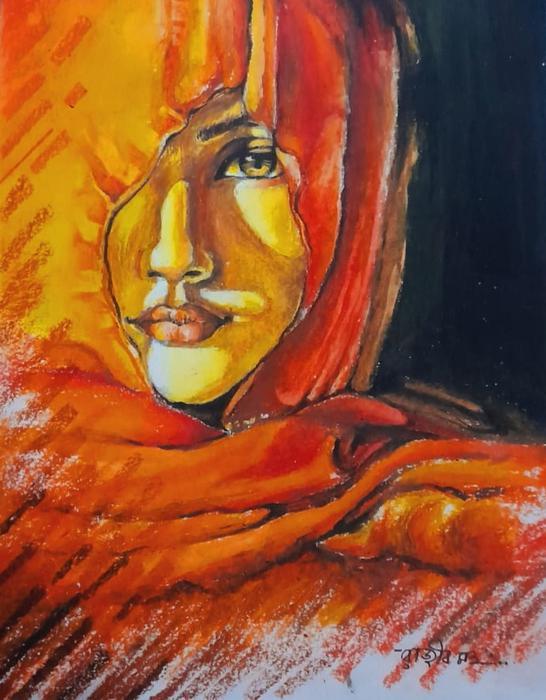Indian traditional painting has a deep cultural and historical significance in Indian art and society. Here are some key points on its importance:
Religious and mythological themes: Indian traditional painting often depict religious and mythological stories from Hindu, Buddhist, Jain, and other faiths. These paintings not only showcase the artistic skills of the painters but also act as a medium to convey spiritual and moral values to the viewers.
Regional diversity: Indian traditional painting has a rich diversity of styles, techniques, and themes across different regions of India. Each style reflects the unique cultural identity and traditions of the region, making it an important part of India’s cultural heritage.
Preservation of history and culture: Traditional Indian paintings often depict historical events, royal courts, and social customs of the past. They offer a glimpse into the rich history and culture of India and help in preserving and document them for future generations.
Healing and therapeutic value: Many traditional Indian paintings, such as Madhubani and Warli art, are considered to have healing and therapeutic properties. These paintings often have symbolic and spiritual meanings that are believed to have a positive impact on mental and physical health.
Economic and social significance: Traditional Indian paintings have also played a significant role in the economic and social development of communities. Many rural and tribal communities rely on painting as a source of income and employment, and the promotion of traditional art forms can help in empowering these communities and preserving their cultural heritage.
Overall, Indian traditional painting holds a unique place in India’s cultural history and continues to be an important art form that showcases the diversity and richness of Indian culture.
Materials used in Indian traditional painting
Indian traditional painting employs a variety of materials, which can vary depending on the style, region, and theme of the painting. Here are some of the commonly used materials:
Pigments: Natural pigments derived from plants, minerals, and animal sources are commonly used in Indian traditional painting. These pigments are often ground and mixed with water, gum, or binder to make paint. Some common pigments include indigo, turmeric, henna, saffron, vermilion, and charcoal.
Surfaces: Traditional Indian paintings are often done on various surfaces such as cloth, paper, wood, and walls. Cloth paintings such as Pattachitra and Kalamkari are made on cotton or silk fabric, while miniature paintings are done on paper or ivory. Walls of temples and homes are often decorated with frescoes and murals.
Brushes: Brushes used in Indian traditional painting are made from natural materials such as animal hair, bamboo, and twigs. The type and size of the brush depend on the style and technique of the painting. For example, in Madhubani’s painting, a bamboo stick is used as a brush.
Adhesives: Adhesives such as gum, resin, and wax are used as binders for pigments. Gum arabic is a common adhesive used in Indian traditional painting, which helps in binding pigments to surfaces.
Gold and silver: Traditional Indian painting often uses gold and silver leaf or powder to add a rich and luxurious effect. These precious metals are used to highlight specific areas or elements of the painting.
Overall, Indian traditional painting employs a wide range of natural and organic materials that are eco-friendly and sustainable. These materials not only add to the unique charm and beauty of traditional Indian painting but also make it a valuable cultural heritage that needs to be preserved for future generations.
Themes and Subjects in Indian traditional painting
Indian traditional painting depicts a wide range of themes and subjects, reflecting the rich cultural diversity and history of India. Here are some of the common themes and subjects:
Religious and mythological stories: Indian traditional painting has a long tradition of depicting religious and mythological stories from Hindu, Buddhist, Jain, and other faiths. These paintings often depict gods, goddesses, and epic stories like the Ramayana, Mahabharata, and Puranas.
Historical events and royalty: Many Indian traditional paintings also depict historical events, battles, and royal courts of the past. These paintings often feature portraits of kings, queens, and other royalty, showcasing their grandeur and opulence.
Nature and wildlife: Indian traditional painting often features elements of nature such as flowers, trees, birds, and animals. These paintings depict the beauty of nature and the harmony between humans and the environment.
Folklore and folk traditions: Many traditional paintings, especially those from rural and tribal regions, depict folklore and folk traditions of the region. These paintings often feature stories, rituals, and customs that are unique to the region.
Love and romance: Indian traditional painting also has a long tradition of depicting love and romance. These paintings often feature couples in various stages of courtship and love, depicting the beauty and emotions of human relationships.
Social and political commentary: Traditional Indian painting has also been used as a medium for social and political commentary. Many paintings depict social issues such as poverty, inequality, and discrimination, while others offer political commentary on the ruling classes and government policies.
Overall, Indian traditional painting reflects the diverse cultural, historical, and social facets of India. The themes and subjects of these paintings offer a glimpse into the rich heritage and traditions of the country, making them an important part of Indian art and culture.
